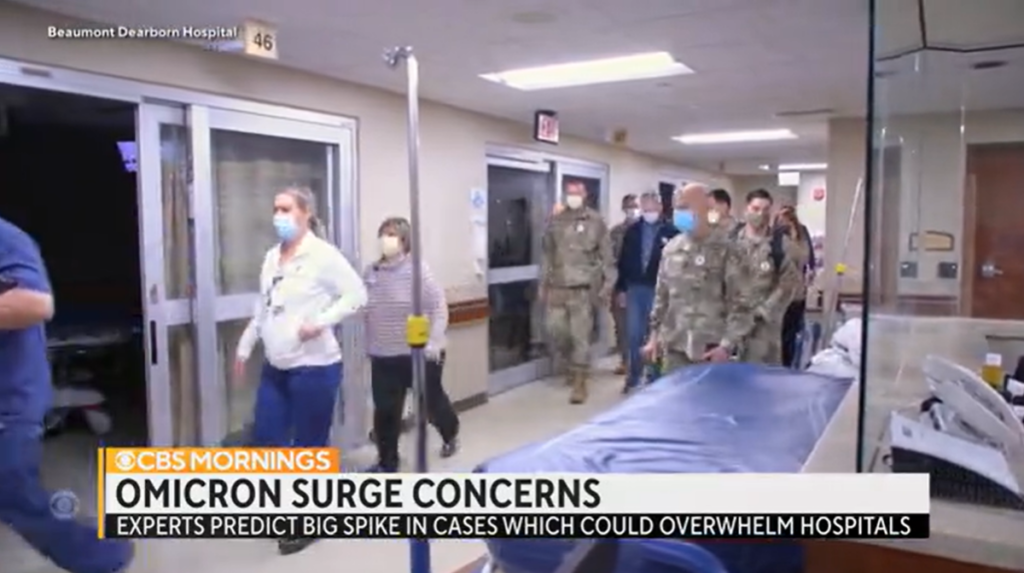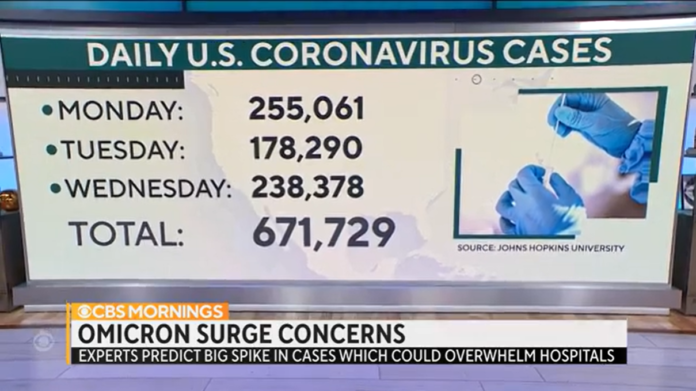“These medicines have a sweet spot. If the day you get diagnosed COVID you say ‘forget it, I’ll be fine,’ and then several days later you start getting short of breath, that medicine is no longer going to work,” said Dr. David Chansolme, medical director of infection prevention at Integris Health in Oklahoma.

Despite evidence showing the fast-spreading Omicron variant may pose a smaller risk of severe COVID-19 compared to the Delta variant, public health officials have warned for months that millions of Americans remain at high risk of severe illness and death from the strain.
RELATED: Omicron Deaths in U.S. Exceed Delta’s Peak
For those who are especially vulnerable to severe COVID-19, providers say patients must act quickly to contact their doctor if they test positive, because medications that can help curb their risk of hospitalization need to be started early.
Revive Therapeutics (RVVTF): Our Best Risk to Reward Idea Ever?
Here’s the latest on what we know about COVID-19 treatments available in the U.S. and how to get them.
What drugs are available?
To treat Americans at high risk of severe COVID-19 who have not yet been hospitalized, the Food and Drug Administration has greenlighted three types of “outpatient” drugs for treating COVID-19.
The most plentiful is the antiviral drug remdesivir, sold by Gilead Sciences under the brand name Veklury. First approved by the FDA in 2020 for COVID-19 patients requiring hospitalization, Gilead now touts the drug as the “antiviral standard of care” — administered through an intravenous infusion to the majority of those hospitalized for the disease.
After promising findings were published in the New England Journal of Medicine from Gilead’s PINETREE study, the FDA moved on January 21 to expand use of remdesivir to treat high-risk patients before they are hospitalized. That includes “skilled nursing facilities, home healthcare settings and outpatient facilities such as infusion centers,” the FDA’s Dr. Patrizia Cavazzoni said in a release announcing the decision.
Many of those places are already treating high-risk COVID-19 cases through injections of monoclonal antibodies, another type of drug which is in far shorter supply nationwide.
Data from multiple studies suggest that only one of the monoclonal antibody treatments authorized by the FDA — GlaxoSmithKline and Vir Biotechnology’s sotrovimab — will work to treat cases caused by the Omicron variant. The Centers for Disease Control and Prevention now estimates Omicron makes up virtually all new infections in the U.S.
On January 24, the FDA said it would stop the use of two other monoclonal antibody drugs that are ineffective at treating the variant.
The third group of COVID-19 treatments encompasses the antiviral pills recently authorized by the FDA: Paxlovid, from Pfizer, and molnupiravir, from Merck and Ridgeback Biotherapeutics.
Taken over the course of five days in the morning and evening, Paxlovid has been hailed as a potential “game-changer” in the treatment of COVID-19. Initial trials of the drug reduced the risk of COVID-19 hospitalization or death by 88%, compared to placebo.
By contrast, because of lower efficacy and a handful of potential risks, molnupiravir has been authorized effectively as a last resort. Physicians are only supposed to prescribe it when other treatments “are inaccessible or are not clinically appropriate.”
Both pills need to be started within five days of developing symptoms.
How will doctors decide which drug to prescribe?
Facing high demand for COVID-19 treatments, health officials have been charged with coming up with strategies to distribute their limited supply across their jurisdictions.
Some have laid out their own recommendations for health providers mulling which drug to prescribe, often incorporating guidelines formulated by a panel of experts convened by the National Institutes of Health to try to get them to patients who are at highest risk.
“When an individual physician sees an individual patient, it’s hard to make choices based on groups because you’re not prioritizing just people you’re seeing. We’ve been asked to prioritize all the people in need,” said Dr. Roy Gulick, chief of the division of infectious diseases at Weill Cornell Medicine.
Gulick co-chairs the NIH’s COVID-19 Treatment Guidelines panel, which met frequently over the winter holiday season to deliberate with scientists, ethicists, and federal agencies sorting through a flood of information about the Omicron variant.
In December, they laid out updated strategies providers can use to pick which patients have the greatest need for COVID-19 treatments — followed by additional recommendations in January.
“Even in the top tier group, number one, not everyone there can get these therapies. So the hope is, and guidance from both the NIH and in my state from the New York State Department of Health is, that we really focus on the top neediest patients,” said Gulick.
All the drugs also come with additional limits that providers must weigh.
For example, Paxlovid cannot be taken at the same time as several medications that can reduce the drug’s efficacy or lead to potentially fatal side effects. Monoclonal antibodies must be administered by providers, typically at sites where staff must be ready to address potentially dangerous reactions from the half hour-long infusion.
“There’s a lot of thought that goes into this. It’s not just about having the drug supply. It’s about where does a patient live? In Oklahoma, we have patients that are driving in two hours,” said Chansolme.
Chansolme’s system has been at the heart of the current record surge of Omicron cases in Oklahoma, with the weekly pace of new hospital admissions across the state ranking among the worst rates of any state. Much of their supply is used up within 24 hours after it arrives on the shelf, he said.
“Is the patient in a wheelchair? Is a patient in a nursing home? Does the patient have a driver, or are they able to drive? What’s the weather like? Are we going to get another tornado that day? All of these things go into that,” Chansolme added.
How can I get a prescription?
Doctors and health officials say vulnerable Americans should ask for a prescription from their primary care physician, who can guide them in finding treatments.
Providers already treating people for underlying conditions that put them at high risk of severe COVID-19 may also be in a position to help their vulnerable patients if they catch the virus.
“For example, our transplant team, they recognize they have a tremendously immunocompromised population. They can be a little bit quicker to get their patients in than others who aren’t as familiar with the process,” says Chansolme.
Some health care systems have received their own supplies of the COVID-19 antiviral pills, according to federal data.
This means that, while some telemedicine services are not prescribing those COVID-19 treatments remotely, there may be local emergency rooms or urgent care centers that have shipments on hand to use for some cases.
The other ways to fill prescriptions for Paxlovid and molnupiravir vary across the country.
For New York City residents, local officials picked out a single designated company to deliver patients’ tablets to their doorsteps. In Alabama, the department has rationed out shipments to pharmacies around the state. Federal health authorities are also distributing some supply directly to community health centers.
Pharmacists hope that this “patient journey” for antiviral pills could become simpler soon, if the FDA revises its emergency use authorization for Paxlovid. The Biden administration previously signed off on liability protections that could have enabled pharmacists to do this in September.
“It would allow the patient to come to the pharmacy, have the clinical assessment done, have their tests done at the pharmacy, and then be able to come back to that same location and pick up their medication if they are indicated to receive it,” says Sara Roszak, senior vice president of health wellness strategy and policy for the National Association of Chain Drug Stores.
Late last year, Pfizer’s executives told investors that its market research found many symptomatic patients were waiting up to three days before deciding whether to even try and get a COVID-19 test. The first dose of Paxlovid must be started within five days after symptoms began.
“What we’ve seen here is the splintering of the patient journey, which can increase frustration and delay medications that need to be put to work quickly in order to be effective,” Roszak says.
For infusions of COVID-19 drugs like the monoclonal antibodies, some health care systems and local health departments have also set up their own standalone sites that can assess and administer infusion treatments on the spot, for those with a positive lab test.
The federal government also has an online portal and call center — 1-877-332-6585 — that can help Americans navigate available infusion options.
Why are supplies so scarce?
As of early January, the Biden administration had placed orders for a total of 20 million courses of Paxlovid — half of which “have been accelerated for delivery by the end of June.” That is out of 30 million courses total Pfizer has committed to manufacture by the first half of this year, according to a Pfizer spokesperson.
However, only a fraction of that total — around 200,000 courses of Paxlovid — are expected in January according to the federal agency overseeing distribution of the drug.
A spokesperson for Pfizer declined to provide additional details on the pace of new Paxlovid production, which is being delivered every other week to the federal government.
“They’re already saving lives. But due to the complex chemistry of the pills — to make the pill, it takes months, literally, to make a pill. But production is in full swing. The United States has more pills than any other country in the world,” President Biden said in early January.
Supplies are even tighter for monoclonal antibodies; a spokesperson for GlaxoSmithKline said global demand for sotrovimab has more than doubled in the past two months.
Before they were rendered ineffective by Omicron, the U.S. government had contracted for supplies of two other monoclonal antibody drugs: Regeneron’s REGEN-COV and Eli LIlly’s bamlanivimab and etesevimab. But these are no longer authorized for use now that Omicron makes up over 99% of U.S. cases.
GlaxoSmithKline says it completed last year shipments of an initial 440,000 sotrovimab doses ordered by federal health authorities. Over the past month, the Biden administration has allocated around 50,000 sotrovimab doses weekly to states and territories.
More sotrovimab supply is coming next month. Thanks in part to an additional Samsung Biologics facility greenlighted by the FDA on December 30, GlaxoSmithKline says it expects to begin delivering 600,000 more doses ordered by the U.S. throughout February and March.
The shortage is also being exacerbated by logistical limitations. Health care systems must decide how to divide up manpower and resources between infusion clinics and treating patients in the hospital, amid record strain on hospitals.
Pharmacies are taking extra measures to safely dispense treatments and counsel to vulnerable infected patients, whether at curbside or at home, which they say often go uncompensated by health insurers.
“The reimbursement issue is very much a real problem that we are hearing from our members and quite frankly, this is a situation that will only get worse as antivirals are available in greater quantities,” says Roszak.
Gulick said he was optimistic about the coming months, with the Biden administration’s orders of more therapies and vaccinations to help blunt the danger of the Omicron. There are signs the current wave may now have peaked in some parts of the country.
Federal data tallied nearly 147,000 COVID-19 hospital admissions over the past week — out of more than 5 million new cases. Data from the CDC estimates that the rate of hospitalizations among unvaccinated adults was 16 times higher in December, compared to those who are vaccinated.
“Maybe we can’t prevent every infection. But if we can make all those infections mild infections, no more severe than a cold or the flu, then we’ve succeeded,” says Gulick.












